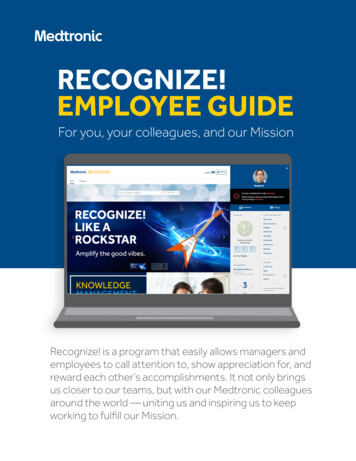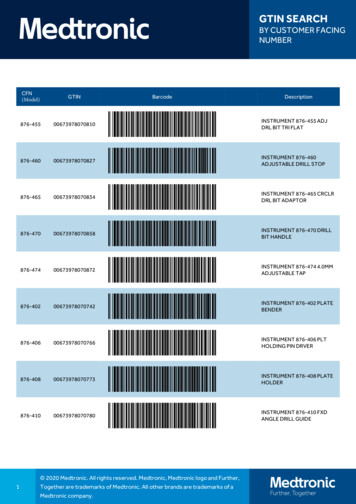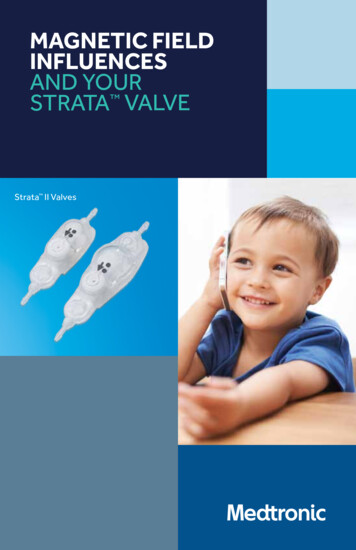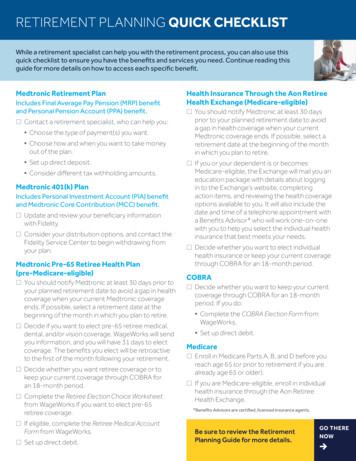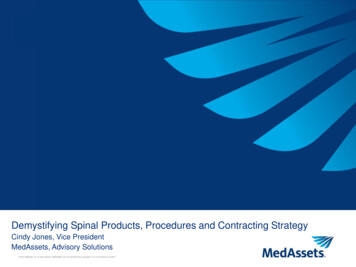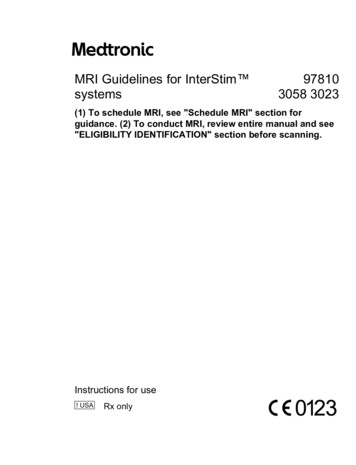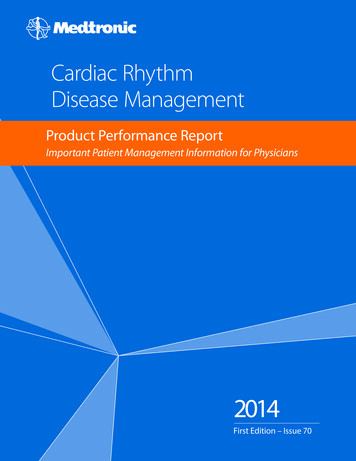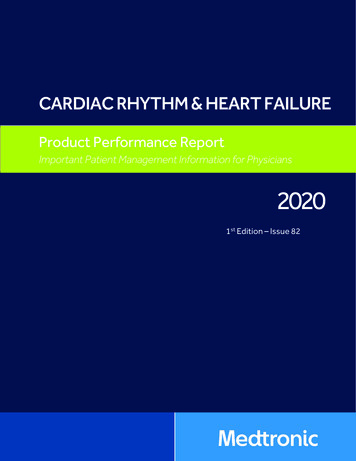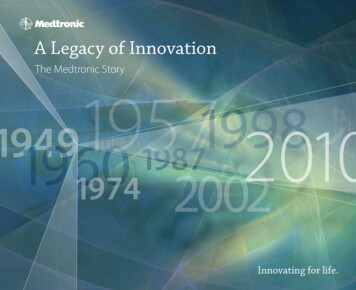
Transcription
A Legacy of InnovationThe Medtronic Story199819571949 19872010196019742002Innovating for life.
“The story of Medtronic is one of men and women who havededicated their lives and careers to helping real peopleovercome pain and disability to lead more normal, happy”lives. It’s a story I never tire of hearing or telling.— Medtronic co-founder Earl Bakken
By the time you finish reading this page, another 10 peoplesomewhere in the world will have been helped by a Medtronictherapy. That’s one person every 4 seconds.What’s even more amazing is that while today we are the global leader in medical technology,we began with two people simply trying to make a difference in the world.This historical compilation is a celebration of our journey and a tribute to our employees. Overthe years, Medtronic employees have stayed true to the spirit of our founders—demonstratingcompassion, drive, and selfless dedication to improve the lives of others. As we celebrate the50th anniversary of the Medtronic Mission in 2010, I’m proud to be leading our company into anew era—expanding our definition of innovation and the many ways in which we can alleviatepain, restore health, and extend life.William A. Hawkins, Chairman and Chief Executive Officer
Over the past 60 years, we’ve transformed Medtronic from a tiny electricalrepair shop in a Minneapolis garage to the world’s leading medicaltechnology company serving customers in more than 120 countries.The common thread that links the company’s activities over all those yearsis innovation. We continually push the boundaries of medical technologyto fulfill our ambitious Mission. Beginning with our legendary advances incardiac pacing, we gradually expanded our technological expertise to treatmany of the world’s most pressing chronic diseases, including heart andvascular disease, diabetes, neurological disorders, and spinal conditions.Today, Medtronic is the global leader in medical technology, with innovativetherapies that improve the lives of millions of people around the world eachyear. And now, a new era of innovation has begun. We’re taking innovationbeyond products and beyond the status quo—looking at ways to improveprocesses, partnerships, and how healthcare is delivered—to continuallyfind more ways to help people live better, longer.HUMBLE BEGINNINGS: Co-founder Palmer Hermundslie persuaded his parents to let him use their Minneapolis garage as Medtronic’s first office.
The Medtronic MissionIn 1960, the board of directors asked co-founder Earl Bakken to developa Mission that would provide strategic focus for the company’s resources.Half a century later, not one word has changed, and the Mission continuesto serve as both our ethical and business compass.The Mission unites employees worldwide in a common goal: to “alleviate pain, restore health, andextend life” in partnership with the medical community. It’s been instrumental in our success andcontinues to be the foundation upon which we build for the future. Our Mission is:nnnnnnTo contribute to human welfare by application of biomedical engineering in the research,design, manufacture, and sale of instruments or appliances that alleviate pain, restore health,and extend life.To direct our growth in the areas of biomedical engineering where we display maximumstrength and ability; to gather people and facilities that tend to augment these areas; tocontinuously build on these areas through education and knowledge assimilation; to avoidparticipation in areas where we cannot make unique and worthy contributions.To strive without reserve for the greatest possible reliability and quality in our products; to bethe unsurpassed standard of comparison; and to be recognized as a company of dedication,honesty, integrity, and service.EVERYDAY REMINDER: Every newemployee worldwide receives a MissionMedallion from senior executivesas a reminder of the honor andresponsibility we all have in fulfillingthe Medtronic Mission.To make a fair profit on current operations to meet our obligations, sustain our growth, andreach our goals.To recognize the personal worth of employees by providing an employment framework thatallows personal satisfaction in work accomplished, security, advancement opportunity, and meansto share in the company’s success.To maintain good citizenship as a company.THE INSPIRATION: Patients like Italiannurse Lina Tedesco have always beenthe driving force at Medtronic. Whenco-founder Earl Bakken would handnew employees a Mission Medallion,he would tell them, “You are here torestore people to full life.”3
A L e g ac y of I n n ovat ion Be g i n s1949-1970INSPIRED INVENTIONS: By serving the medical community,co-founder Earl Bakken was using his engineering expertise tohelp humankind.
When an electrical engineering student volunteered to repairmedical machinery, he began a journey that would lead to oneof the world’s most important medical breakthroughs.C h a nne li ng a Pa s sionGlobal ExpansionWhen Medtronic co-founder Earl Bakken was an electrical engineering graduate student at theUniversity of Minnesota, he spent much of his spare time at nearby University and NorthwesternHospitals. He served as an eager volunteer handyman, repairing malfunctioning medicalequipment so he could learn how it worked. When Earl mentioned this to his brother-in-law, theenterprising Palmer Hermundslie recognized a business opportunity. So, in 1949, the two starteda repair company focused on medical electronics, and called it Medtronic. Their office was theHermundslies’ 600-square-foot garage in northeast Minneapolis, Minnesota.From a Minneapolis garage,Medtronic expanded into a secondgarage and then an apartment.By 1961, we moved to an official15,000-square-foot headquarters inSt. Anthony Village in Minneapolis.It was expanded five-fold within adecade, including adding a state-ofthe-art clean room for assemblingimplantables. By 1970, we movedour U.S. manufacturing facilities toa plant in the Minneapolis suburbof Fridley. To serve a growingEuropean business, Medtronicopened a round-the-clock servicecenter in Amsterdam’s SchipholAirport in 1967. Soon after, a majormanufacturing facility was added inKerkrade, The Netherlands.Hi s tor ic Pa rtne r shipIn addition to repairing medical equipment, Earl also built custom equipment for clients, includingDr. C. Walton Lillihei, a pioneering open-heart surgeon at the University of Minnesota Hospitals.Dr. Lillihei often treated infants with congenital heart defects, and used a pacemaker after surgerywhile the heart healed. At that time, pacemakers were bulky, AC-powered boxes that had to bewheeled on carts and plugged into outlets.One night, an electrical storm caused a power outage and one of Dr. Lillihei’s pediatric heartpatients died. Despondent, the surgeon turned to Earl for a battery-powered alternative. Within fourweeks, he delivered the world’s first battery-operated external cardiac pacemaker.Historic Milestones1949195719591960n M edtronic founded to ser vicen M ed troni c i ncor porates.n D ebuts annual Holid ay Pro gra m i nn S i gn s exc l u s i ve co nt ra c t to p ro d u ceel ec tro n ic m edic a l equipm ent.n D evelops first wearable, ex ter nalbatter y- operated pacemaker.which several patient s te l l e m p l oye e show thei r M ed troni c d e v ice s h averestored thei r li ves.n Fi rst shares i ssued.an d m ar ke t im p lant ab le p ace m ake rd e ve lo p e d by Wilso n Gre at b atc h an dDr. William C h ard ac k .n M issio n d e ve lo p e d.n S a l e s fo rce e s t a b l i s h e d w i t h 1 4 re p sse r v in g U. S. an d Can ad a.5
Technology EvolutionLeadershipThis innovative pacemaker was called a “miracle,” and orders started coming in from around theworld. While it was a significant breakthrough for treating short-term heart rate irregularities, thepacemaker’s limited battery life constrained its uses. Physicians began requesting a more longterm, implantable pacemaker for patients with permanent cardiac conditions. So we developed arudimentary semi-implantable pacemaker in 1959, but the battery still had to be replaced almostmonthly, so we continued to work on a better solution.For the first eight years, Medtronicwas led by co-founders andbrothers-in-law Earl Bakken andPalmer Hermundslie. Earl providedthe engineering expertise whilePalmer handled sales and businessoperations. Earl then became ChiefExecutive Officer and Chairmanof the Board from the company’sincorporation in 1957 until 1976.The first successful U.S. attempt at designing a totally implantable pacemaker was reported bythe New York team of Drs. William Chardack and Andrew Gage, and engineer Wilson Greatbatch.Medtronic’s founders contacted them about a partnership, and soon we had exclusive rights toproduce and market the Chardack-Greatbatch implantable pacemaker. By the end of that year, 1960,we had 50 orders for the device and were now considered the experts in cardiac electrical stimulation.Sales steadily grew, but the cost of the device, 300 to 500, was prohibitive for many patients. Areal breakthrough for sales was passage of Medicare legislation in 1965, which covered the cost of apacemaker for elderly patients.T r a n sf e r r ing Expe rt i s e In to N ew A r e a sDuring this era, we developed several heart-related products, including a heart monitor anda generator that controlled bleeding during surgery. We also began transferring our electricalstimulation expertise to treat other conditions. In partnership with Case Western Reserve University,Medtronic tested stimulation of the spinal cord to suppress pain. By the end of the 1960s, we alsowere exploring the use of electrical stimulation to treat varicose veins and gastrointestinal conditions.6HISTORIC PARTNERSHIP: Dr. C. Walton Lillihei, a pioneeringopen-heart surgeon, requested that Medtronic developa battery-operated pacemaker for his young patients toeliminate reliance on unpredictable AC power.EARLY INGENUITY: The inspiration for the battery-operatedexternal cardiac pacemaker (left) was the circuit for anelectronic metronome that Earl Bakken saw in an issue ofPopular Electronics magazine.ENTREPRENEUR TO EXECUTIVE:Co-founder Earl Bakken graduallytransitioned from an introverted engineerto a passionate executive who helpedMedtronic become a world leader inmedical technology.MOVING INSIDE: Medtronic gained exclusive rights to produceand market the Chardack-Greatbatch implantable pacemaker.
Financial GrowthMedtronic’s first monthly gross was a mere 8 for repairing a centrifuge. By 1960, annual sales were 180,000, and two yearslater they reached 500,000. The profit picture, however, wasn’t as promising. The combination of a new facility, increasedmarketing expenses, and significant research investment resulted in a 44,000 loss in 1962.On the edge of bankruptcy, we battled back by obtaining a 100,000 bank installment promissory note, attracting moneyfrom a venture capitalist, and trimming staff. By 1963, the company was back on track financially and reported a 73,000profit on revenues of 985,000. That year, we sold an average 100 pacemakers per month, with about 20% of total salescoming from foreign markets.KEEPING THE COMPANY ALOFT: Co-founder PalmerHermundslie, who oversaw the business side of Medtronic,often piloted his Beechcraft Bonanza to visit customers andmake emergency pacemaker deliveries.850NUMBER OFE M P LOY E E S225170 27.1mA nnualR evenueY ear 8 180,00019491960 4.0m19651970BRINGING ELECTRICITY TO LIFE: Our first logo reinforced ourfocus on electrical engineering for the medical community.Historic Milestones19601964196719691970n Pro d u ce s i m plantable cardiacn Sto c k l is ted on NASDAQ.n D evelops demand pacemakers,n Establish e s i nte r n at i o n a ln I nt ro d u ce s f i r s t n u c l e a r- p owe re dp a cem a k er s.whi ch provi d e pulse only whenneed ed.d i vi si on.c ard iac p ace m ake r.7
GEOGR A PH IC A N D PRODUCT DI VERS I TY1971-1990EUROPEAN EXPANSION: During this period, we addeda major manufacturing facility in Tolochenaz, Switzerland.HUMBLE BEGINNINGS: Medtronic co-founder Earl Bakkendeveloped the world’s first wearable pacemaker in a Minneapolisgarage, which served as the company’s first office.Facility photo here
Through internal development and selective acquisitions,Medtronic catapulted from a small pacing company into adiversified, worldwide medical technology leader.Expa ndi ng in to Ne urol o g ic al t h e r api e sGlobal ExpansionBy the time we reached our 25th anniversary in 1974, we were marketing products directly in morethan 70 countries. The majority of worldwide sales, about 80%, were still in the cardiac pacingbusiness, but we began aggressively applying our electrical stimulation expertise to developneurological products. In 1975, the Neurological Division was officially established.In the 1970s, Medtronic enjoyed 35%of the cardiac pacemaker marketoutside the United States and wecontinued to expand our globalpresence. We established a LatinAmerican headquarters inSao Paulo, Brazil, in 1971; a Europeanheadquarters in Paris in 1972;and an Asia/Pacific headquartersin Kawasaki, Japan, in 1975. Wealso opened manufacturingfacilities in Puerto Rico, Argentina,Canada, and France. To serve bothphysicians and Medtronic salesorganizations overseas, we openedBakken Education Centers in Indiaand Japan. In the States, we addednew Minnesota facilities to houseour growing Neurological andCardioVascular businesses.We continued our work on electrical neurostimulators to treat pain, and began pivotal work withFrench neurosurgeon Prof. Alim-Louis Benabid on deep brain stimulation to treat the devastatingeffects of movement disorders, such as essential tremor and Parkinson’s disease.Br a nc hing Ou t f rom t h e H e a rtIn 1977, Medtronic moved into cardiovascular therapies. We established a Heart Valves Divisionand introduced the Medtronic‑Hall mechanical heart valve. Named for Dr. Karl Victor Hall, theNorwegian surgeon who worked with us to develop it, this prosthetic valve had no welds, joints,or bends that could eventually weaken the valve’s structure.In addition to developing new cardiovascular therapies internally, we also acquired manytechnologies. These included tissue heart valves and cardiopulmonary equipment fromJohnson & Johnson, coronary angioplasty catheters and guiding catheters from VersaflexDelivery Systems, and centrifugal blood pumps for heart surgery from Bio-Medicus.Historic Milestones1975197619771978n E s ta bl is h es N euro l o gic a l Div is io n.n Ear l Bak ken opens The Bak ken: An Establi shes Hear t Va lve Div isio n wit hn M e d t ro n i c Fo u n d at i o n i n co r p o rate s toLibrar y and Museum of Elec tricit y inLife i n M i nneapoli s, M i nnesota.introduc tion of mec h a n i c a l p ro s t h e t i chear t valve.a d va n ce t h e co m p a ny ’s p h i l a nt h ro p i cac t iv it ie s.n Stock listed on New Yo r k Sto c kExchange und er ti ck e r sym b o l MDT.n I ntroduces longer-la s t i n g l i t h i u mbatter i es i n pacemake r s.9
A n Importa n t Pair ingIn 1981, we introduced the world’s first implantable, programmable drug pump to treat cancerpain. Unlike oral medications that affect the whole body, our implantable drug pump deliveredmedication at the dose that was needed, directly where it was needed—to the fluid-filled spacearound the spinal cord. It was an important first step in combining Medtronic devices withmedication to provide targeted drug delivery.Later, we introduced a steroid-tipped pacemaker lead. After the lead was implanted, the steroidmedication helped reduce tissue inflammation to speed healing.Financial GrowthIn 1977, Medtronic went public, with our stock traded on the New York Stock Exchange. By 1985, we were listedamong the Fortune 500 largest publicly held companies in America. Ironically, in the same year, we reported ourfirst decline in sales and earnings in 23 years. Three key factors played a role: 1) Private insurers began paying a fixedfee for medical devices and surgeries, driving a decline in pacemaker implants, 2) New medical device companiestook away market share, and 3) We issued our first major product recall. With a new CEO and a new strategicdirection (see Win Wallin under Leadership on facing page), we were back on track and earnings nearly tripledwithin five years.Rewarding innovation: In 1979, we establishedthe prestigious Bakken Society to honor significantcontributions by scientists and engineers.7, 0 0 0NUMBER OFE M P LOY E E S4,6001,0145,0002,600 865.9mDrug Delivery Pioneer: We developed the firstimplantable, programmable pump to deliver medicationto the spinal cord to treat pain and the muscle tightnessof spasticity.A nnualR evenue 370.4m 253.1m 100.6m 32.9mY ear1019711975198019851990
LeadershipIn 1976, Medtronic reached outsidefor a president and chief executiveofficer, tapping Dale R. Olseth,president and chief executive ofTonka Corporation. The formerinvestment banker, who had beenon Medtronic’s board since 1973,brought a toughness and disciplineto operations that was necessary aswe went public.Olseth was succeeded by WinstonR. (Win) Wallin in 1985. Wallin, aMedtronic board member andformer vice chairman of the PillsburyCompany, came on at a financiallow point, with earnings, stock priceand market share all depressed. Heemphasized product diversificationas a panacea. Annual researchspending doubled in Wallin’s firstthree years, from 37 million to 75million, representing 11% of revenue.In addition to driving productdevelopment, he also initiatedseveral key acquisitions and broughton the first physician to serve in thecompany’s executive leadership,Dr. Glen Nelson.BEST OF BOTH WORLDS: Medtronic’s success has been the result of both internal innovations like the Medtronic-Hall mechanicalheart valve (left), and technology acquisitions like the porcine (pig) tissue valve (right).MEETING DEMAND: We increased staff by 40% from 1985 to 1990 to meet increasing demand for our products.Historic Milestones1979198119841985198619871990n E s t a b l i s h e s Then I ntroduces firstn National S ociet y ofn J oi ns the For t une 500n Acquires D utc hn Acq u i re sn Acqu ire s B io - M e d ic u s,B a k k e n S o c iet y toh o n o r s i gn i ficantco nt r i b u t i o ns bys c i e nt i s t s a ndengineer s.implantable,pro gra m m a bl e dr ugpum p fo r c a n cer pa in.Professi onal Engi neersnames the card i acpacemaker one ofthe 10 outstandingengineer ing produc tsof the past half centur y.list with sales of 370mi lli on.pacemakermanuf ac turer Vit at ro n .c a rd i ova s c u l a r d i v i s i o no f Jo h n so n & Jo h n so n .t h e wo r ld ’s larg e stm a n u f a c t u re r o fce nt r i f u g a l b l o o dp u m p s.11
F rom De v ic e s to L i f e l on g S ol u t ion sEASIER FOLLOW-UP: For patients who live inremote areas, like this boy from Australia’s Outback,our wireless and Internet-based remote monitoringsystems eliminate regular office visits.
With chronic disease escalating into a worldwide epidemic,we’re developing therapies that provide lifelong solutions—to improve lives and reduce cost.Broade ning Our S c opeGlobal ExpansionIn the 1990s, we expanded our focus to address chronic disease, the leading cause of mortalityworldwide and a significant financial burden on society. In addition to therapies for cardiovascularand heart disease, we added therapies to treat other long-term conditions like diabetes, movementdisorders, and spinal conditions.The 1990s began with the building ofa manufacturing facility and pacingresearch center in Japan. In 1991, ourEuropean headquarters was movedfrom Paris to Brussels, Belgium, andthen to Tolochenaz, Switzerlandsix years later. In 2009, we movedour Asia/Pacific headquarters toSingapore. Anticipating growthin the 21st century, we built a newworld headquarters in 2001 in Fridley,Minnesota, a suburb of Minneapolis.As of 2010, Medtronic operatedmore than 300 manufacturingfacilities, sales offices, researchcenters, education centers, andadministration facilities servingcustomers in more than 120countries.Many of our innovations were developed internally, but we also made and continue to makestrategic acquisitions that can help us bring new therapies to the world faster or more costeffectively. Key acquisitions since 1991 include:nAneuRx for stent grafts to treat aortic aneurysmsnPhysio-Control for external automated defibrillators that treat sudden cardiac arrestnMidas Rex for high-speed surgical drillsnXomed for ear, nose, and throat surgical instrumentsnSofamor Danek and Kyphon for therapies to treat spinal conditionsnArterial Vascular Engineering (AVE) for coronary artery stentsnMiniMed for insulin pumps to treat diabetesnCryoCath and Ablation Frontiers for therapies to treat atrial fibrillationnInvatec for stents and angioplasty balloons to treat peripheral vascular disease.Historic Milestones199619971998199819992001n Acq u ires AneuR x,n I ntroduces instrument forn D oubles i n si ze af tern Named one of the “100n Ce l e b rate s 5 0 t hn Acqu ire s d iab e te s le ad e rm a n u f a c t u re r ofend ova sc u l a r s tent gra f ts.im m o bil izin g th e b eati nghear t dur ing coronar yby pa s s s urger y.n I ntro duces fir s t deepbrain stimulator to treatsymptoms of essentialtrem o r.acquir ing spinal leaderS ofamor Danek , coronar ystent manuf ac turer Ar ter i alVascular Engineer ing,wor ld lead er i n ex ter nald ef i br i llators Physi o Control, surgi cal per f usi onmanufac turer Avecor,and maker of high-speedsurgi cal d r i lls M i d as R ex.B est Compani es To Wor kFor i n Amer i ca” by For t unemagazine.an n ive r sar y wit h n e w lo g o.n I nt ro d u ce s s a c ra l n e r ven e u ro st im u lato r fo r u r in ar yco nt ro l.M in iM e d, u ro lo gic alco m p a ny Vi d a M e d, a n dg ast ro e nte ro lo gic alm an u f ac t u re r E n d o n e t ic s.n Acq u i re s Xo m e d, a l e a d e ri n s u rgi c a l e a r, n o s e, a n dt h ro at p ro d u c t s.13
A Mor e Holi s t ic Vi e wL e s s i n va s i v e to t h e Hu m a n B odyMost of our medical devices treat an acute problem that requiresimmediate attention, such as heart failure or a ruptured aorta.Increasingly, we’re using our expertise and vast experience to developtherapies that help patients earlier and later in the lifecycle of theircondition.Another way we’re helping reduce healthcare costs is by makingour therapies less invasive. This leads to shorter surgery time, shorterhospital stays, and faster healing—making therapies easier on patientswhile reducing cost. One notable example is our transcatheter deliveryof heart valves and stents. The devices are placed in a thin tubecalled a catheter, which is inserted through a small cut in the thigh,eliminating the need to open the chest to place our products.For example, we’re pairing our devices with information technologyto make long-term follow-up easier and less costly—especially forpatients who live in remote areas. Our remote monitoring systemssend device data securely over the Internet to a patient’s healthcareteam, eliminating some routine in-office visits.A n On g oi n g Mi s sionWhile Medtronic today touches many more areas of healthcare thanwe did back in 1949, our tenacity and passion are driven by the samephilosophy that drove our co-founders: continually strive for moreways to help people live better, longer.Financial GrowthContinuous introduction of innovative products moved us past the 1 billion mark in annual revenue in 1991. In themost recent two decades, Medtronic revenue has grown at an annual compound rate of 16%. As a nod to our financialstrength, Medtronic received the number-one ranking on 100 Best Stocks to Own in America in 1997, 1999, and 2002.40,000NUMBER OFE M P LOY E E S21,6007,60030,0008,900 15.82bA nnualR evenue 10.05b 5.02b 1.02bY ear141991 2.09b1995200020052010
Leveraging Our Core Technologiesto Treat More Chronic ConditionsLeadershipWilliam W. (Bill) George becamePresident and CEO in 1991. Theformer president of Honeywell’sspace and aviation systems businesscontinued the diversification strategybegun by Win Wallin. Under George’s10-year leadership, Medtronic’smarket capitalization grew from 1.1billion to 60 billion, averaging 35%a year.c h r o n i c co n d i t i o n culoskeletalTraumaDRUG ANDBIOLOGICS onicCoreTechnologiesSURGICALNAVIGATION ANDIMAGINGChronic andCancer PainIn 2001, Arthur D. (Art) Collinstook over the top leadership role.He focused Medtronic on treatingchronic diseases, a growing andcostly epidemic. Collins also ledus into a new era of convergingtechnologies, leveraging informationtechnologies like the Internet toimprove how patients manage theirconditions. During Collins’ six-yeartenure, revenues grew at an annualcompound rate of 15%. WilliamA. (Bill) Hawkins became our sixthChairman and CEO in 2007. Underhis leadership, Medtronic is takinginnovation to a new level, beyondjust products, to bring greaterproductivity and promise to thehealthcare system.DIAGNOSTICSMECHANICALDEVICESEar, Nose, isordersUrological andDigestiveDisordersHistoric Milestones2002200220062007200820092010n I ntro du ces rem o ten I ntroduces firstn I ntroduces firstn I ntroduces firstn I ntrod uces d rug-n I nt ro d u ce s f ir st d e e pn I nt ro d u ce s f i r s tm o nito r ing tosec u rel y t ran s fer dataf ro m sel ec t dev icesto d o c to r s v ia th eI nter net.bone mor phogeneticprotein produc tto treat spinaldegenerative discdis ea s e.n I ntro duces fir s t deepbra in s tim ul ato r totreat s y m pto m s o fPa r k in s o n’s dis ea s e.i nsuli n pump wi threal-time continuousglucose moni tor i ng.ar tificial disc for usei n cer vi cal spi ne.n Acq ui res Kyphon,a lead er i n spi naltechnologi es.eluting coronar ystent.n Acquires Cr yoCat hTechnologi es, wor ldleader in cr yothe ra pyfor cardiac arrhythmias.b rain st im u lato r tot re at o b se ssive co m p u lsive d iso rd e r(H DE ap p roval).n Acq u i re s Ab l at i o nt ran sc at h e te r h e ar tvalve.n Acq u i re s I nvate c, al e a d e r i n s te nt s a n dan gio p last y b allo o n s.Fro nt i e r s, a co m p a nyd e ve l o p i n g c a rd i a car r hyt h m ia t h e rap ie s.15
InnovationOne of Medtronic’s greatest assets is our culture of innovation. This foundingtenet helps attract the best and brightest minds, drive ongoing financialperformance, and improve more and more lives each year.B old T h i n k e r sOne key to our ongoing success in developing breakthrough technologies is hiring peoplewho share our founders’ passion for pushing boundaries. Medtronic employees are smart,inquisitive, and driven to excel. We look for ideas in unexpected places and push each otherto go further.R & D C ommi tme n tPUSHING BOUNDARIES: Medtronic was the first to introducean insulin pump combined with a real-time continuousglucose monitoring system that makes it easier for diabetespatients like PInkal Patel to manage their blood glucoselevels. The next step will be developing a closed-loopsystem that delivers insulin automatically.In the early days, Medtronic’s research and development (R&D) was carried out on makeshiftwooden tables, with notes and sketches drawn on paper bags. Beginning in the 1980s,Medtronic made a serious commitment to R&D, investing approximately 10% of sales annuallyto future efforts. The investment has paid off in performance: Medtronic ranked No. 1 in medicaldevice patents issued from 1969 through 1998, InformationWeek magazine named Medtronic oneof 500 Relentless Innovators in 2009, and in 2010 MIT Technology Review named Medtronic one ofthe 50 Most Innovative Companies for our work in deep brain stimulation therapy.Today, Medtronic’s 9,000 scientists and engineers work from our 26 state-of-the-art researchcenters around the world.S h a r i n g Ide a s a n d T e c h n ol o gy Plat f or m sMedtronic works hard to ensure our diverse employees and businesses share technologyplatforms and ideas to improve efficiency and speed innovation. An office of Science andTechnology oversees key R&D activities that can be leveraged across the company, andcollaboration tools, such as blogs and videoconferencing, allow employees in differentcountries and business units to communicate.Ta k i n g In n ovat ion F u rt h e r16Medtronic recognizes that truly fulfilling our Mission requires thinking beyond products.We also look at how we can improve processes, break down barriers, and reduce healthcarecosts—to continually find more ways to help people live better, longer.
28 18Therapies that address many of the world’smost pressing chronic diseasesCardiac Rhythm Conditions32Urological and DigestiveConditions2 Fast Heart Rates (Tachycardia)*20 Sinus Diseases**3 Heart Failure*21 Thyroid Conditions4 Asymptomatic, Irregular Heart Rates*22 Otologic Disorders**36 Overactive Bladder and UrinaryRetention37 Benign Prostatic Hyperplasia (BPH)5 Atrial Fibrillation23 Sleep-Disordered Breathing25 Ménière’s Disease6 Coronary Artery Disease8 Congenital Heart DiseaseDental, Cranial and OralMaxillofacial Conditions9 Rheumatic Heart Disease26 Jawbone Deficiencies10 Heart Valve Disease27 Oral Maxillofacial Trauma11 Aortic Disease28 Craniofacial Defects7 Peripheral Arterial DiseaseSpinal Conditions andMusculoskeletal TraumaNeurological Conditions13 Scoliosis**29 Parkinson’s Disease** and EssentialTremor**30 Dystonia †**14 Degenerative Disc Disease**31 Hydrocephalus**15 Spinal Fracture**32 Obsessive-Compulsive Disorder †16 Lumbar Spinal Stenosis**18 Cranial and Pelvic Trauma**33 Severe Spasticity Associated withCerebral Palsy, Stroke, Brain andSpinal Cord Injury, and MultipleSclerosis19 Subdural Hematomas34 Brain Tumors and Other Lesions**12 Cervical Herniated Disc**17 Tibial Fractures**2223 2726Ear, Nose, and ThroatConditionsCardiova
European business, Medtronic opened a round-the-clock service center in Amsterdam's Schiphol Airport in 1967. Soon after, a major manufacturing facility was added in Kerkrade, The Netherlands. 1949 1957 1959 1960 n Medtronic founded to service electronic medical equipment. n Medtronic incorporates. n Develops first wearable, external


